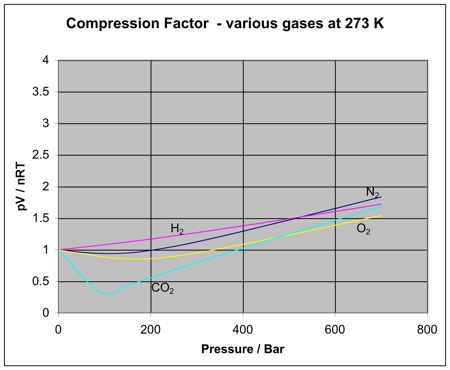Why does ideal gas law fail at times?
2 Answers
The ideal gas law is based on some assumptions about gases which are not always true - that gas particles have no volume and are not attracted to each other.
Explanation:
One idea that the ideal gas law is based upon is that gas particles have no volume. If gas particles really had no volume, you could condense a gas into smaller and smaller volumes to have eventually zero volume.
So why doesn't this work with real gases? Well, real gases have volume. As they become compressed into smaller and smaller volume, the particles get closer and closer to each other to the point where the particles are no longer in the gas phase, they become a liquid or solid = gas laws no longer can be used to predict what these particles will do because they are no longer in the gas phase.
Another assumption of the ideal gas law is that gas particles have no attraction to each other. Real gas particles are attracted to each other. Eventually if you get them moving slowly enough (cooling) and get them close together their attractive forces will cause them to condense. No they are not gas particles anymore!
Skip to 12:50 in this video for more discussion of this topic...
Simply put, not all gases are ideal. Some gases compress more easily or more difficultly than others. This is determined by the compressibility factor
The value for
#color(blue)(Z ~~ (PbarV)/(RT)) -= (PV)/(nRT)# ,with
#barV = V/n# , the molar volume (I find it convenient to write#barV# for reasons related to making the more complicated equations of state [EOSs], like the Redlich-Kwong, look nicer).
(If you wish to find the true
For
- If
#Z < 1# , the gas has a smaller volume than the ideal volume, and thus, is more easily compressed than an ideal gas. - If
#Z = 1# , the gas is completely ideal. - If
#Z > 1# , the gas has a larger volume than the ideal volume, and thus, is less easily compressed than an ideal gas.
For instance, the true
Assuming ideality, we would use
#color(green)(barV) = (RT)/(P) = ((("0.083145 L"cdot"bar")/("mol"cdot"K"))("288.15 K"))/("1.013 bar")#
#=# #color(green)("23.651 L/mol")#
On the other hand, if we properly use the actual value of
#color(blue)(barV) = (ZRT)/(P) = (0.99435*(("0.083145 L"cdot"bar")/("mol"cdot"K"))("288.15 K"))/("1.013 bar")#
#~~# #color(blue)("23.517 L/mol")#
And that matches our prediction; if
Thus, it makes sense that the gas is more easily compressed at a specific pressure and temperature of comparison than if it were completely ideal. In the case of
EXERCISES:
- If you attempt to compare molar volumes for
#"CO"_2# at higher pressures, it just gets worse, especially at, say,#"100 bar"# . Try it, using a new#Z# of#~0.3# !

- Try the same calculations on
#"SO"_2# ! For this gas, the true#Z = 0.98025# at#"1.013 bar"# and#15^@ "C"# . You should see#barV = "23.184 L/mol"# , which is about#1.97%# lower.


